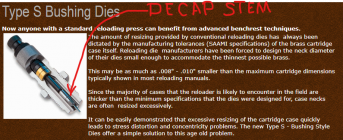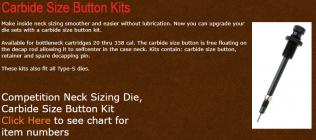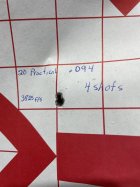I'd be inclined to take nakneker up on his Lake City brass offer. It is almost impossible to find Lake City out there that is not processed right now. Good deal. When I first started loading 20 p around 10-14 years ago, I could only get my hands on a large quantity of Remington once-fired commercial brass. It is noticeably softer than other brands - but still held up to 7 or 8 firings in my 20P A/R's, though I annealed after every 2 or 3 firings. You won't get but a few more firings with Lake City, but you will get a bit less trimming in between firings and the primer pockets hold up a bit better. I have read a fair number of bad reviews about Starline brass, but have no personal experience with it. I've read far more bad reviews about Remington - which worked out just fine for me.
That said, the 20P is very easy to load for. I use a Redding bushing die and it works great. Using any Military brass, you will likely want to first run it through a small-base die. While most Lake City brass doesn't require it, you will eventually get some pieces that cause problems otherwise, that were fired in oversized chambers. In one of my 20P's, I have to use a small-base die on every sizing due to the tight chamber which was chambered with a PTG reamer.
I first run once-fired Lake City through the small-base die, then size with the FL bushing die, using a .232" bushing. I then open necks up with an expander, skim turn the necks to 90%+ clean metal, then size with a .222" bushing, ready to load. I take about .001" off skim turning. Then I anneal. That is WAY more steps than necessary to get good brass with Lake City - this is just what I found to be a method for very uniform brass. Thereafter, I just size normally, using the .222" bushing. If not turning and using commercial brass like Starline, Remington, etc., I'd just go straight to a .223" bushing with either commercial brass, then anneal if you have that available to you - though not necessary. I'd pick up several bushings as not all brass is the same in thickness. For the range you described, you will find it hard to find a better cartridge that doesn't heat up the barrel and enable you to see the hits due to the low recoil. While most folks don't like to turn brass, it really makes a difference on the smaller diameter calibers, such as this one. The good thing is - you don't have to do it - but you can add that to your list of brass prep if and when you are looking for a bit more accuracy later on down the road. It makes a bigger difference than on .223-and-up sized cartridges in my experience. Be sure to try 32 and 40 V-Max and 39 Blitz King bullets, along with Accurate LT32 powder. Have yet to see a rig that won't shoot those reasonably well.
That said, the 20P is very easy to load for. I use a Redding bushing die and it works great. Using any Military brass, you will likely want to first run it through a small-base die. While most Lake City brass doesn't require it, you will eventually get some pieces that cause problems otherwise, that were fired in oversized chambers. In one of my 20P's, I have to use a small-base die on every sizing due to the tight chamber which was chambered with a PTG reamer.
I first run once-fired Lake City through the small-base die, then size with the FL bushing die, using a .232" bushing. I then open necks up with an expander, skim turn the necks to 90%+ clean metal, then size with a .222" bushing, ready to load. I take about .001" off skim turning. Then I anneal. That is WAY more steps than necessary to get good brass with Lake City - this is just what I found to be a method for very uniform brass. Thereafter, I just size normally, using the .222" bushing. If not turning and using commercial brass like Starline, Remington, etc., I'd just go straight to a .223" bushing with either commercial brass, then anneal if you have that available to you - though not necessary. I'd pick up several bushings as not all brass is the same in thickness. For the range you described, you will find it hard to find a better cartridge that doesn't heat up the barrel and enable you to see the hits due to the low recoil. While most folks don't like to turn brass, it really makes a difference on the smaller diameter calibers, such as this one. The good thing is - you don't have to do it - but you can add that to your list of brass prep if and when you are looking for a bit more accuracy later on down the road. It makes a bigger difference than on .223-and-up sized cartridges in my experience. Be sure to try 32 and 40 V-Max and 39 Blitz King bullets, along with Accurate LT32 powder. Have yet to see a rig that won't shoot those reasonably well.













